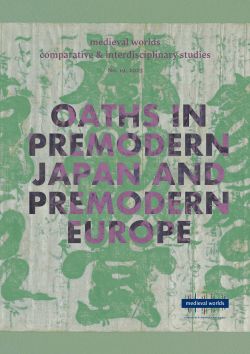Yoshikawa Shinji
S. 22 - 39
doi:
10.1553/medievalworlds_no19_2023s22
Verlag der Österreichischen Akademie der Wissenschaften
doi:
10.1553/medievalworlds_no19_2023s22
Abstract:
In medieval and early modern Japan, a style of written oath, called kishōmon, came into existence. Recent archaeological excavations have made it possible to prove that the kishōmon appeared in the twelfth century at the latest. This article recounts the process through which these sources originated and developed into the kishōmon format. Divinatory curses, called ukei, existed in Ancient Japan (already in the third to sixth century CE), and they provided the basis for requesting divine judgment or swearing oaths. During the seventh through eleventh centuries, the Japanese state consolidated its authority and a new type of political oath came into being. Initially, these oaths resembled those employed in China, although oaths in this format may also have been used in Japan for diplomacy. Next, oaths influenced by Buddhist prayers came to the fore whereby the oath-taker cursed himself if his statements were untrue. Finally, Buddhist oaths became prominent, in which other persons than the oath-taker were cursed as well. After the ninth century, the Chinese-style political culture withered within Japan, and only Buddhist oaths remained. Although oaths cursing others would remain, the self-curse would become the foundation for standard contracts in later times. As medieval society emerged in Japan, and predicated upon these customs and beliefs, the kishōmon came into being.
Kishōmon (written oaths), ukei (divinatory curses), shinpan (divine judgments), Chinese style oaths, Buddhist oaths, standard contracts
Published Online:
2023/11/30 08:53:02
Object Identifier:
0xc1aa5576 0x003ea4f5
Rights:https://creativecommons.org/licenses/by-nc-nd/4.0/
"medieval worlds" provides a forum for comparative, interdisciplinary and transcultural studies of the Middle Ages. Its aim is to overcome disciplinary boundaries, regional limits and national research traditions in Medieval Studies, to open up new spaces for discussion, and to help developing global perspectives. We focus on the period from c. 400 to 1500 CE but do not stick to rigid periodization.
medieval worlds is open to submissions of broadly comparative studies and matters of global interest, whether in single articles, companion papers, smaller clusters, or special issues on a subject of global/comparative history. We particularly invite studies of wide-ranging connectivity or comparison between different world regions.
Apart from research articles, medieval worlds publishes ongoing debates and project and conference reports on comparative medieval research.
In this volume, guest editors Philippe Buc and Thomas D. Conlan use oaths as the pivotal point for their comparative thematic section. Focusing on the differences and similarities between Japanese and European oath-taking and oath-breaking practices during the medieval period, on terminology and on chronology, Philippe Buc provides an introduction that contextualises the studies in this collection. For Japan, Yoshikawa S. and T.D. Conlan give insights into the development of the written oath (kishōmon) from its predecessors and origins in the third to sixth centuries to the sixteenth century, M. Gilbert and Horikawa Y. provide case studies of kishōmon in the heyday of its use. For Western Europe, S. Esders outlines the development of oaths from Late Antiquity to the tenth century under Christian doctrinal influence. In three case studies, H. Reimitz, H. Débax and O. Richard illustrate the use of oaths in the Early, High and Late Middle Ages.
In our individual articles section, E. Worrall, R. Kramer and T. Grant offer a new edition and commented translation of an Icelandic fragment of the Nikuláss saga erkibiskups, the Saga of Bishop Nicholas.




 Home
Home Print
Print
 References
References
 Share
Share
